Contents
Market Overview
Macro Review
FOMC minutes cue tapering from mid-November. Minutes also revealed that the composition of tapering would reduce U.S. Treasury purchases by $10bn and MBS purchases by $5bn each month, implying that it would take eight months to exhaust the pandemic intervention measures. We have also seen Eurodollar futures increasingly price in rate hikes in 2022 (1.8 hikes) with a full hike priced-in for 3Q22 with higher CPI. The theme globally is one of inflation pivoting and responding to “stagflationary winds”. The Bank of England have already shown their stripes, as have the National Bank of Poland, but this week it was the Banco Central de Chile’s turn. The Chilean Central Bank hiked 125bp as it seeks to tackle rising inflation expectations (5y5y swaps now at 6.50%). Elsewhere, Chinese assets did not react to PPI surging at the fastest pace since 1995 (10.7%) while CPI missed expectations coming in at 0.7%. In fact, the 10ppts differential between Chinese PPI and CPI is at its largest since 1993, as a more extreme conundrum than the U.S. is facing. Meanwhile, GDP data is due on Monday and should reveal the extent of coal shortages and weakness in the property sector through 3Q. The extent of Europe’s energy crisis weighed heavily on industrial production, which was noticeably weak, and could offer some insight into the Chinese GDP impact. This comes as the IMF threw caution to the wind on inflation as meetings kicked-off in Washington DC, just as Georgieva’s credibility wanes. Speaking of credibility, Erdogan reshuffled the Turkish MPC at the CBRT by reducing the number of voters to six from seven. Three members were sacked, which included the rumored successor to Governor Kavcioglu, an individual with alleged links to FETO and a member who opposed the September rate cut. Instead, these changes create an uncertain back-drop where a rate cut is now more likely at the next meeting on Thursday. Nearer-term the key theme in the Chinese property focuses on willingness versus the ability to pay. Within this theme, Shimao, Kaisa and Sinic are the latest casualties to come under renewed scrutiny.
EM Local Update
Following JP Morgan’s index consultation, Egypt and Ukraine will enter the GBI-EM (EM Local Bond index). Egypt will have an estimated weight of 1.85% from the end of January, where Ukraine will have a smaller weight of 0.12% from the end of March. In somewhat ironic fashion, Egypt’s index weight will exceed Turkey (1.82%). Nevertheless, the additions of Egypt and Ukraine follow a long drawn-out marketing process, although further sweeteners come with the prospect of India and Kazakhstan being added to the index in due course.
EM Credit Update
EM Credit ended the week up 0.5% as U.S. Treasury curves bull flattened. Lithuania, El Salvador and Iraq outperformed, while Sri Lanka, Ghana and Suriname lagged. The focus remains on the ETF tracking the EM Sovereign Index (EMB), especially with a drawdown of -4.40% since the early September peak. The EMB also registered a “death cross” this week with the 50dma declining through the 200dma, however since then the ETF is already up 1.0% as modest outflows reversed.
The Week Ahead
China’s 3Q GDP is the main fixture of next week, followed by retail sales and industrial production. We would expect loan prime rates to also remain unchanged (1yr at 3.85% and 5yr at 4.65%), but the larger focus lies with the prospect of a RRR cut. Following the changes at the CBRT, Turkey’s MPC decision is as soon as Thursday with a cut in the policy rate increasingly likely (18.0%). Beyond Turkey, Russia are expected to hike once again (6.75%), with further rate decisions from Hungary (1.65%), Indonesia (3.5%) and Ukraine (8.5%). Then inflation from Hong Kong, Israel, Mexico, Poland and South Africa is also due.
Highlights from emerging markets discussed below include: Turkey’s pre-mature monetary policy easing likely to continue under mounting political pressure, signaling further FX weakness and market volatility; and Mexico’s growth-damaging electricity reform bill unlikely to pass in current form.
Fixed Income
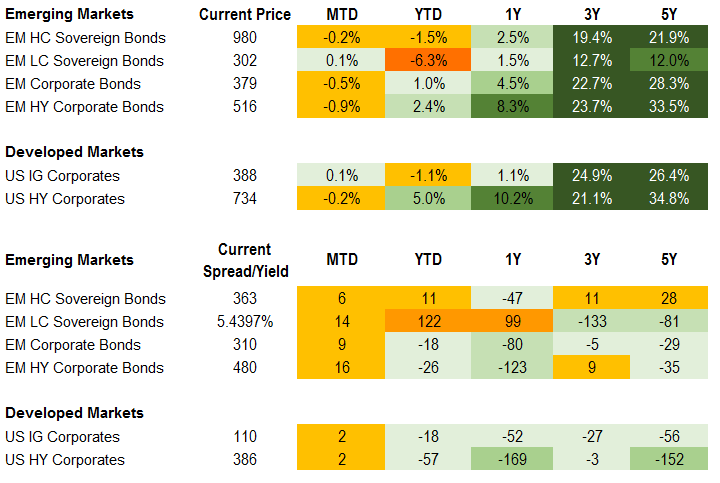
Equities
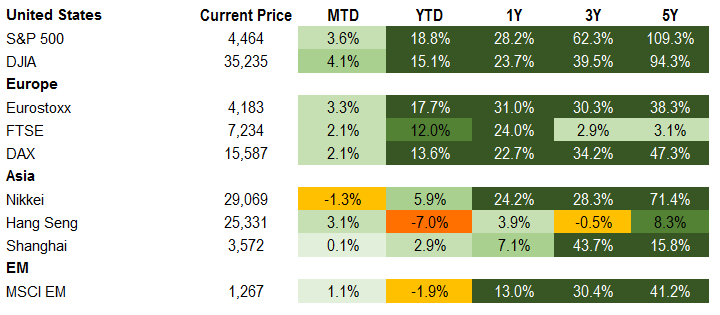
Commodities

Source for data tables: Bloomberg, JPMorgan, Gramercy. EM Fixed Income is represented by the following JPMorgan Indicies: EMBI Global, GBI-EM Global Diversified, CEMBI Broad Diversified and CEMBI Broad High Yield. DM Fixed Income is represented by the JPMorgan JULI Total Return Index and Domestic High Yield Index. Fixed Income, Equity and Commodity data is as of October 15, 2021 (mid-afternoon).
Emerging Markets Weekly Highlights
Turkey’s pre-mature monetary policy easing likely to continue under mounting political pressure, signaling further FX weakness and market volatility
Event: President Erdogan fired three of the Central Bank’s (CBRT) Monetary Policy Committee (MPC) members by a mid-night decree, adhering to his approach of overnight dismissals of central bank officials who have fallen out of grace.
Gramercy Commentary: As a reminder, market-friendly former CBRT Governor Agbal was fired in similar style by President Erdogan back in March, which triggered the start of the TRY’s spectacular ongoing depreciation trend to around 9.20 against the USD now, from around 7.0 in March, equating to more than 30% nominal weakening. The latest CBRT high-level dismissals include the only MPC member who voted against the 100bps rate cut delivered last month that marked the beginning of what we believe is a pre-mature policy easing cycle. This cements our long-held view that the CBRT’s reaction function is likely to get even more closely aligned with the government’s policy/political priorities and further detached from the underlying macroeconomic trends in the Turkish and global economies going forward. As such, despite unsupportive fundamental dynamics, we believe more policy easing is in the pipeline for the rest of the year in the context of some likely modest disinflation in November/December (driven exclusively by base effect) and the Central Bank’s creative and rather flexible criteria for justifying rate cuts. If the CBRT gets too aggressive with policy easing (starting with next week’s MPC decision), that might trigger a renewed dollarization trend by local corporate and retail savers, potentially driving more rapid currency depreciation and reinforcing the well-known vicious cycle of FX weakness and inflation. We think that a politically constrained central bank would be unwilling and unable to deliver an orthodox response in such a scenario, while the government’s own policy toolkit is also limited. This increases the risk of further policy credibility erosion and potential serious market disruption, in our view. Furthermore, the current policy mix exacerbates Turkey’s vulnerabilities to external headwinds, in the form of gradual tightening of global financial conditions and higher energy prices, among others. Against this confluence of near-term risks, we brace for significant volatility in Turkish markets by year-end. We are more constructive on Turkey’s medium-term prospects and will be watching for tactical opportunities in the event a market dislocation occurs.
Mexico’s growth-damaging electricity reform bill unlikely to pass in current form
Event: The Head of the Lower Chamber’s Energy Committee, Manuel Rodriguez, stated he was willing to amend the controversial and credit-negative electricity reform presented by President Lopez Obrador to Congress earlier this month. This followed initial divisions within the opposition coalition related to prospects for PRI support. The legislation aims to roll back the changes made in 2013 to enhance private sector involvement in the energy sector. More specifically, it mandates that CFE generate at least 54% of the country’s energy needs (up from 38%), increases state control over CFE and Pemex, eliminates regulators CNH (National Hydrocarbons Commission) and CRE (Regulatory Energy Commission), and prohibits the granting of new lithium or energy transition-related concessions.
Gramercy Commentary: We expect the opposition to successfully block the passage of the bill as it currently stands despite some initial indications of support within the PRI, however, we anticipate AMLO’s efforts and initiatives to prioritize the state’s role in the energy industry to persist. Given that these would be constitutional changes, they require a two-thirds majority in both houses. The government needs 57 opposition votes in the House and 12 opposition votes in the Senate to pass the legislation, assuming a full quorum and Morena and working allies all voting in favor. There is no set deadline for the votes but there is an informal target for a vote in the House before the current session ends in mid-December. The ultimate scope and scale of the reform and measures will determine the extent and pace of erosion of growth prospects, fiscal costs, USCMA issues, and credit headwinds for the sovereign over the medium term.
Emerging Markets Technicals
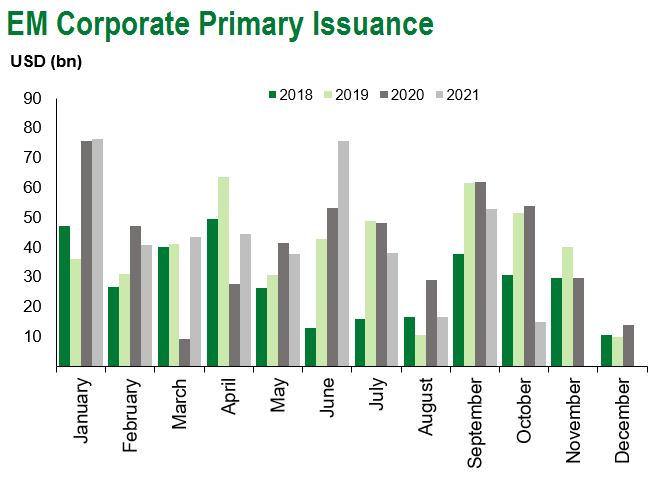
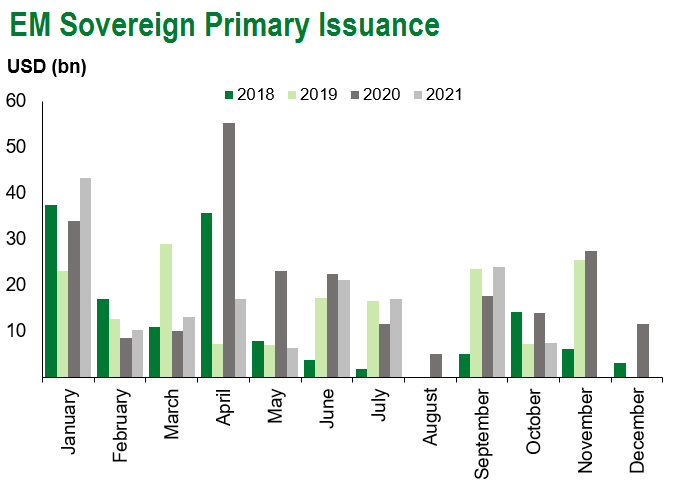
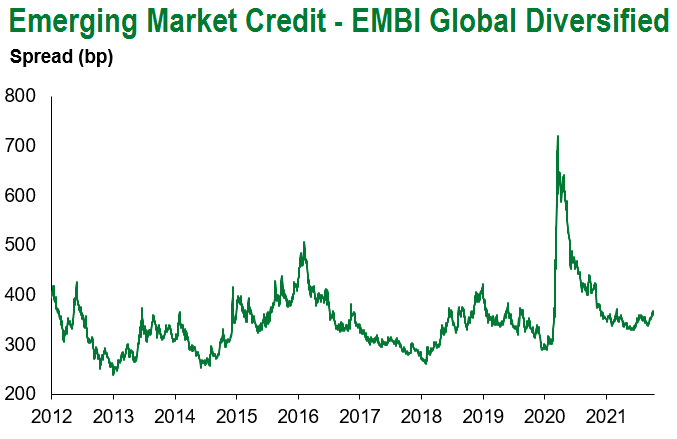
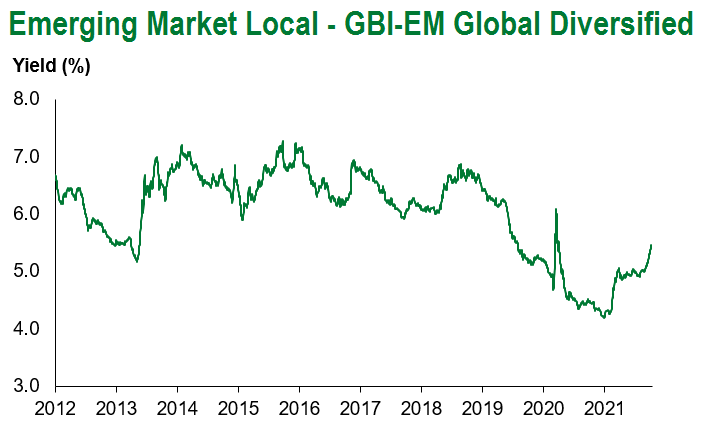
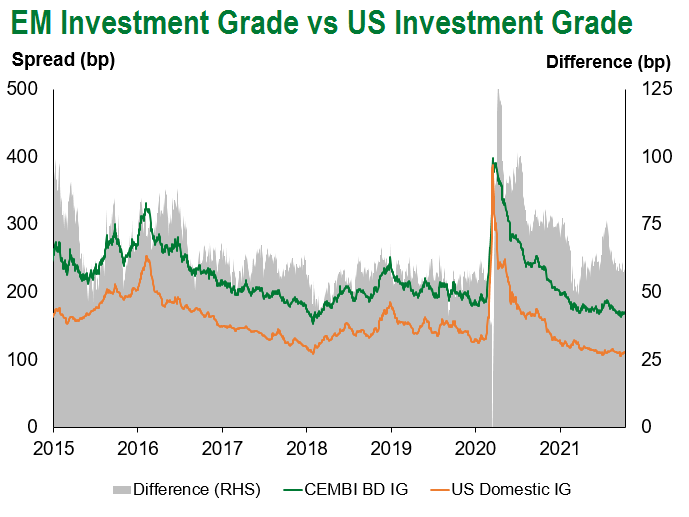
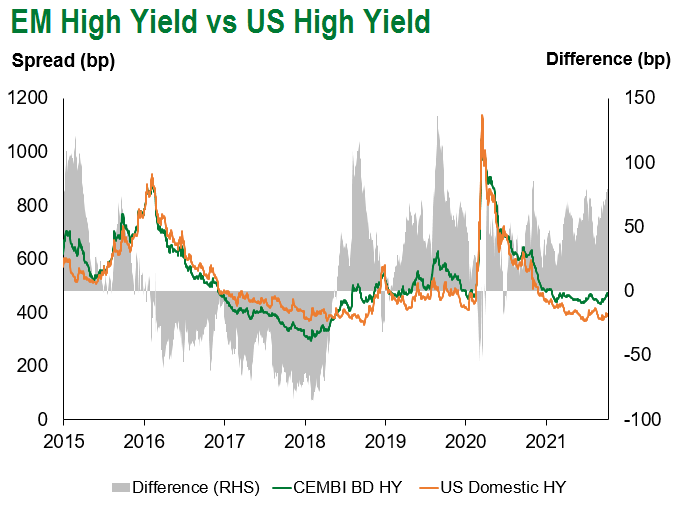
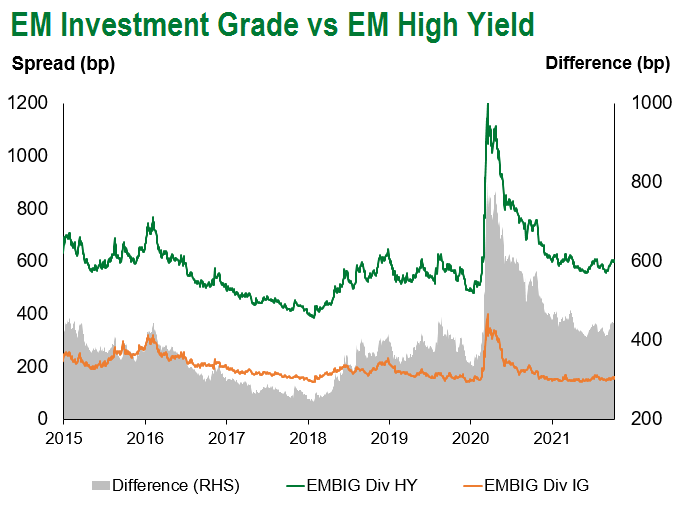
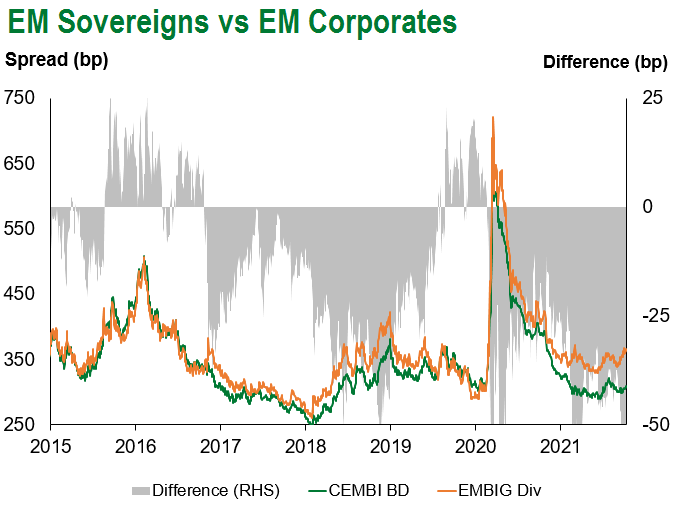
Emerging Markets Flows
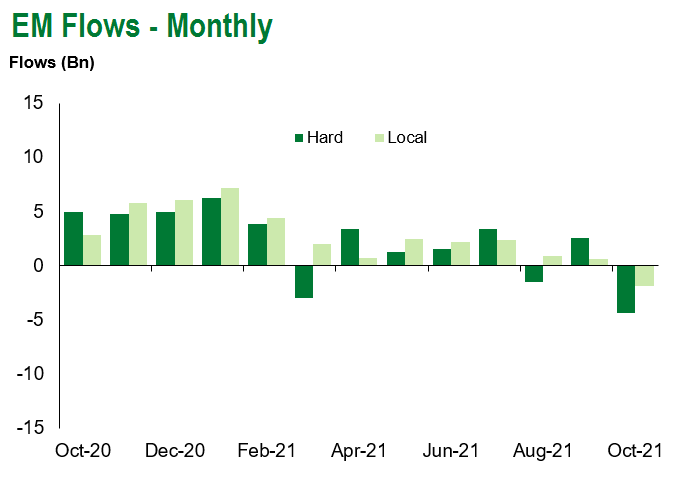
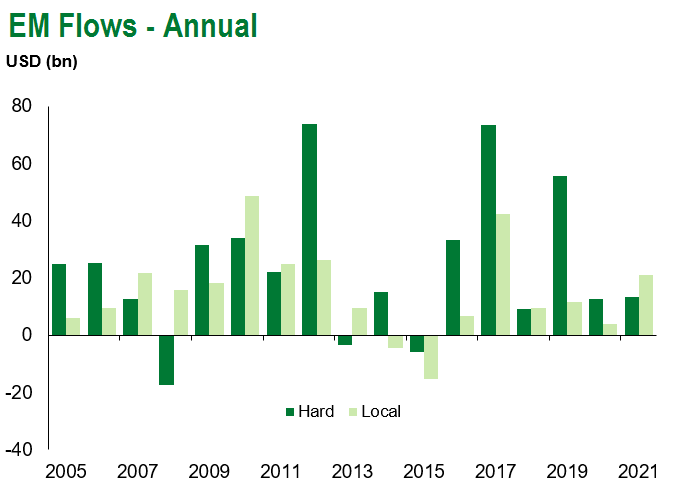
Source for graphs: Bloomberg, JPMorgan, Gramercy. As of October 15, 2021.
COVID Resources
Emerging Markets COVID-19 Case Summary
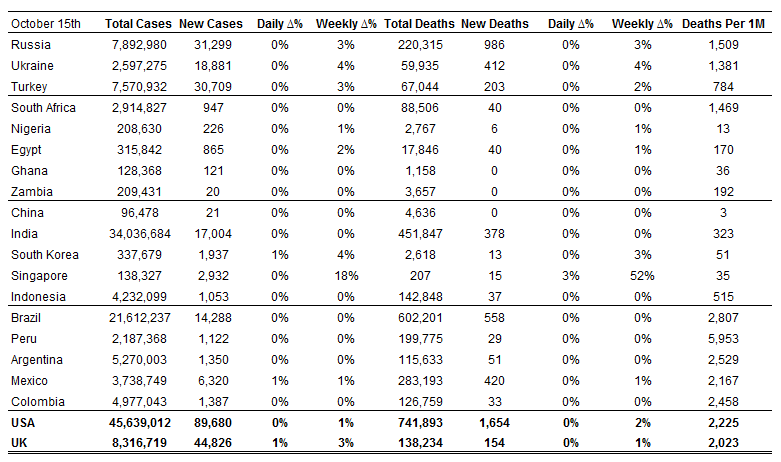
Source: Worldometer as of October 15, 2021.
Additional Crisis Resources:
Johns Hopkins COVID-19 Case Tracker
For questions, please contact:
Kathryn Exum, Senior Vice President, Sovereign Research Analyst, [email protected]
Petar Atanasov, Senior Vice President, Sovereign Research Analyst, [email protected]
Tolu Alamutu, CFA, Senior Vice President, Corporate Research Analyst, [email protected]
James Barry, Vice President, Corporate Research Analyst, [email protected]
This document is for informational purposes only. The information presented is not intended to be relied upon as a forecast, research or investment advice, and is not a recommendation, offer or solicitation to buy or sell any securities or to adopt any investment strategy. Gramercy may have current investment positions in the securities or sovereigns mentioned above. The information and opinions contained in this paper are as of the date of initial publication, derived from proprietary and nonproprietary sources deemed by Gramercy to be reliable, are not necessarily all-inclusive and are not guaranteed as to accuracy. This paper may contain “forward-looking” information that is not purely historical in nature. Such information may include, among other things, projections and forecasts. There is no guarantee that any forecasts made will come to pass. Reliance upon information in this paper is at the sole discretion of the reader. You should not rely on this presentation as the basis upon which to make an investment decision. Investment involves risk. There can be no assurance that investment objectives will be achieved. Investors must be prepared to bear the risk of a total loss of their investment. These risks are often heightened for investments in emerging/developing markets or smaller capital markets. International investing involves risks, including risks related to foreign currency, limited liquidity, less government regulation, and the possibility of substantial volatility due to adverse political, economic or other developments. The information provided herein is neither tax nor legal advice. Investors should speak to their tax professional for specific information regarding their tax situation.